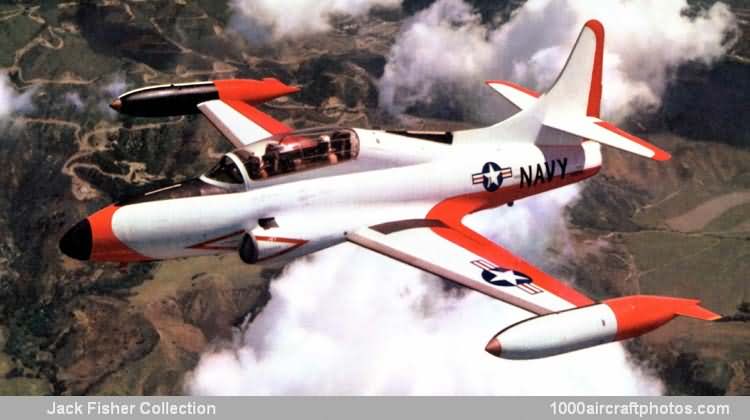Under the overall guidance of Kelly Johnson, the design team sought to achieve significant gains in the instructor pilot's work efficiency and in the aircraft's low-speed handling characteristics. The former was to be achieved by raising the instructor's seat 6 in (15.2 cm) and by installing a revised canopy, thus greatly increasing the instructor's forward view. The latter by incorporating leading edge slats, enlarged tail surfaces, and a system of boundary-layer control with compressed air being bled from the engine compressor chambers and discharged through slots over the top of the slats. The combination of these changes was expected to result in a reduction in landing and take off speeds of 4.6 mph (7.4 kmh) and 8 mph (13 kmh) respectively over those of the T-33A.
Confident that its projected aircraft, which bore the Temporary Design Designation number L-245, would attract customers, Lockheed decided to proceed with the construction of a demonstrator. To that effect it bought back from the USAF an uncompleted T-33A airframe (c/n 580-7321, s/n 52-9255) and proceeded to modify it as a prototype of the L-245. Simply named the Lockheed Trainer, and unofficially known as the T-33B, this aircraft was completed at the end of November 1953 and was assigned the civil registration N125D.
This company-owned prototype was first flown at the Lockheed Air Terminal on December 16, 1953, but its initial trials revealed the need for some modifications. In particular, the raised cockpit-which gave the aircraft a distinctive hunchback appearance-resulted in unsatisfactory airflow over the vertical tail surfaces and necessitated the addition of a large dorsal fin. Some redesign of the tailpipe for its 5,400 lb (2,449 kg) thrust Allison J33-A-16A turbojet was also found necessary.
Demonstration of the aircraft to the USAF failed to generate interest as it was satisfied with the standard T-33A. The US Navy, however, was impressed by the lower take off and landing speeds and saw in this aircraft the potential for a much needed jet deck-landing trainer. This interest led in May 1954 to the award of an initial contract for eight T2V-1s (BuNos. 142261 to 142268, Lockheed Model 1080-91-08) to be powered by 6,100 lb (2,767 kg) thrust Allison J33-A-24 or J33-A-24A turbojets.
These deck-landing trainers were to be fitted with non-jettisonable tip tanks, an arrester hook, and strengthened airframe and landing gear. The landing gear, to be capable of withstanding more than twice the sink rate allowed for the TV-2, was characterized by an hydraulically-adjustable nose unit to raise the nose for improved climb and catapult take off capability.
In advance of the first T2V-1 SeaStar, Lockheed modified its demonstrator into an aerodynamic prototype for the naval trainer by fitting it with the revised nose landing gear, arrester hook, and revised tail cone. The modified aircraft, painted in USN training colors but retaining its civil registration, was completed in November 1954 and underwent an extensive flight-test program, followed by structural and functional testing. Simulated catapult take offs and arrested landings were made at China Lake Naval Testing Station, California, to confirm carrier suitability of structures and equipment, and the experience gained during these tests was incorporated in the final design of the T2V -1 production model.
The first of these aircraft (BuNo. 142261), which differed from the company-owned prototype in having an airframe strengthened to the full production standard and in being fitted with revised main landing gear, began its flight trials on January 20, 1956. Eighteen months later, the T2V-1 underwent carrier qualification trials aboard the USS Antietam in the hands of personnel from the Flight Test Division, Naval Air Test Center.
Four additional batches of T2V-1s were delivered to the USN (BuNos. 142397 to 142399, 142533 to 142541, 144117 to 144126, 144735 to 144764) to bring total production to 150 SeaStars. However, follow-on contracts for 240 T2V-1s (BuNos. 144765 to 144824, 146058 to 146237) were cancelled.
The T2V-1 (redesignated T-1A on September 18, 1962) entered service at NAS Pensacola in late 1957. Although proving a docile deck-landing jet trainer, the SeaStar had a relatively short service life as its boundary-layer control system - the first to be used on a production aircraft in the United States - proved the source of protracted maintenance problems. In any event, the US Navy soon decided to provide initial jet carrier-landing experience with the lower-performance North American T2J-1 (T-2A), with the T2V-1 being used only for advanced training. The availability of the Grumman F9F-8T
(TF-9J), which could also be used as a weapons delivery trainer, led to the early retirement of the unarmed SeaStar."
Span: 42 ft 10 in (13.06 m)
Length: 38 ft 6t in (11.75 m)
Height: 13 ft 4 in (4.06 m)
Wing area: 240 sq.ft (22,297 sq.m)
Weight empty: 11,965 lb (5,427 kg)
Loaded weight: 15,500 lb (7,031 kg)
Max speed: 580 mph (933 kmh) at 35,000 ft (10,670 m)
Climb: 6,330 ft (1,929 m)/min
Service ceiling: 40,000 ft (12,190 m)
Range: 970 mls (1,560 km)
